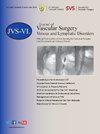Comparison of clinical outcomes among patients with proximal versus isolated distal deep vein thrombosis: A systematic review and meta-analysis
IF 2.8
2区 医学
Q2 PERIPHERAL VASCULAR DISEASE
Journal of vascular surgery. Venous and lymphatic disorders
Pub Date : 2025-06-20
DOI:10.1016/j.jvsv.2025.102281
引用次数: 0
Abstract
Objective
Deep vein thrombosis (DVT) ranks among the top five most prevalent vascular diseases globally and encompasses proximal deep vein thrombosis (PDVT) and isolated distal deep vein thrombosis (IDDVT). IDDVT affects approximately 50% to 65% of patients with DVT. However, due to a lack of prospective studies and conflicting perspectives on its potential to lead to pulmonary embolism (PE), the management of IDDVT remains contentious. Therefore, this meta-analysis was conducted to compare the clinical outcomes of PDVT and IDDVT.
Method
We searched studies including proximal and isolated distal thrombotic outcomes in the electronic databases PubMed, EMBASE, Cochrane, and Web of Science. The literature was then screened based on title, abstract, and full text to exclude those that did not meet the criteria. A total of 21 cohort and randomized controlled studies were included.
Results
Compared with IDDVT, PDVT was associated with higher rates in recurrent vein thromboembolism (VTE) (odds ratio [OR], 1.62; 95% confidence interval [CI], 1.35-1.93; P < .001), PE (OR, 1.52; 95% CI, 1.16-1.99; P = .002), major bleeding (OR, 1.95; 95% CI, 1.23-3.09; P = .005), and all-cause mortality (OR, 2.02; 95% CI, 1.19-3.44; P = .009). However, no significant differences were found in the rates of any bleeding (OR, 1.57; 95% CI, 0.96-2.58; P = .070) and nonmajor bleeding (OR, 1.03; 95% CI, 0.69-1.54; P = .88).
Conclusions
Compared with patients with PDVT, patients with IDDVT may have lower rates of recurrent VTE, PE, major bleeding events, and all-cause mortality, demonstrating safer clinical outcomes.
近端与孤立性远端深静脉血栓患者的临床结果比较:一项系统回顾和荟萃分析。
目的:深静脉血栓形成(Deep vein thrombosis, DVT)是全球最常见的五大血管疾病之一,包括近端深静脉血栓形成(PDVT)和孤立性远端深静脉血栓形成(IDDVT)。IDDVT影响约50-65%的DVT患者。然而,由于缺乏前瞻性研究和对其导致肺栓塞(PE)的可能性的相互矛盾的观点,IDDVT的管理仍然存在争议。因此,本荟萃分析比较PDVT和IDDVT的临床结果。方法:我们在PubMed、EMBASE、Cochrane和Web of Science的电子数据库中检索了包括近端和孤立的远端血栓结局的研究。然后根据标题、摘要和全文筛选文献,以排除不符合标准的文献。共纳入21项队列和随机对照研究。结果:与IDDVT相比,PDVT与更高的静脉血栓栓塞复发率相关(OR: 1.62;95% CI:1.35-1.93, p < 0.001), PE (OR: 1.52;95% CI: 1.16-1.99, p = 0.002),大出血(OR: 1.95;95% CI: 1.23-3.09, p = 0.005)和全因死亡率(OR: 2.02;95% CI: 1.19-3.44, p = 0.009)。然而,在任何出血(OR: 1.57 95% CI: 0.96-2.58, p = 0.070)和非大出血(OR: 1.03;95% CI: 0.69-1.54, p = 0.88)。结论:与PDVT相比,IDDVT患者复发性VTE、PE、大出血事件和全因死亡率可能更低,临床结果更安全。
本文章由计算机程序翻译,如有差异,请以英文原文为准。
求助全文
约1分钟内获得全文
求助全文
来源期刊

Journal of vascular surgery. Venous and lymphatic disorders
SURGERYPERIPHERAL VASCULAR DISEASE&n-PERIPHERAL VASCULAR DISEASE
CiteScore
6.30
自引率
18.80%
发文量
328
审稿时长
71 days
期刊介绍:
Journal of Vascular Surgery: Venous and Lymphatic Disorders is one of a series of specialist journals launched by the Journal of Vascular Surgery. It aims to be the premier international Journal of medical, endovascular and surgical management of venous and lymphatic disorders. It publishes high quality clinical, research, case reports, techniques, and practice manuscripts related to all aspects of venous and lymphatic disorders, including malformations and wound care, with an emphasis on the practicing clinician. The journal seeks to provide novel and timely information to vascular surgeons, interventionalists, phlebologists, wound care specialists, and allied health professionals who treat patients presenting with vascular and lymphatic disorders. As the official publication of The Society for Vascular Surgery and the American Venous Forum, the Journal will publish, after peer review, selected papers presented at the annual meeting of these organizations and affiliated vascular societies, as well as original articles from members and non-members.
 求助内容:
求助内容: 应助结果提醒方式:
应助结果提醒方式:


